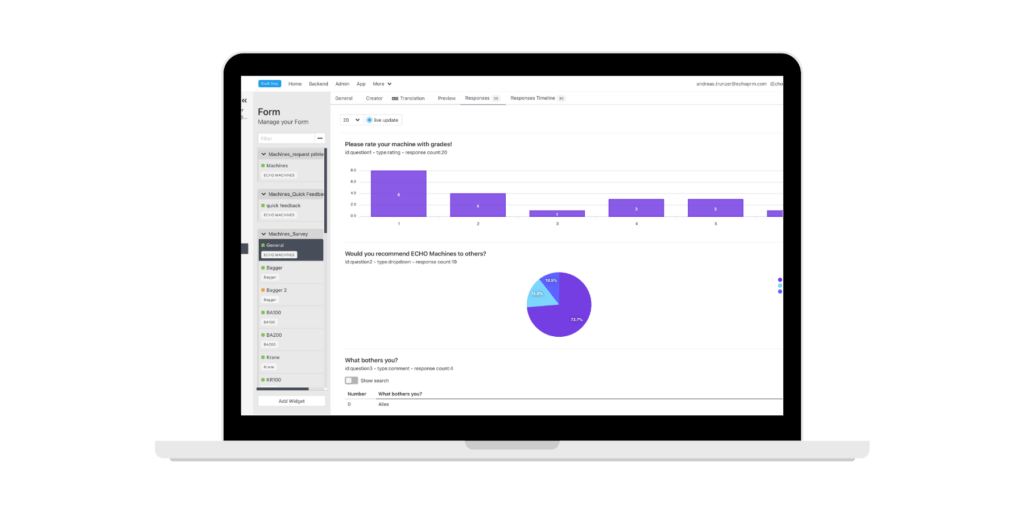The components
ECHO Backend
With the ECHO PRM modules, the presentation, structure and all information to be displayed via the web app can be defined and managed.
ECHO PRM MODULES
In the Design module, the corporate identity of your company, consisting of colours and your logo, can be designed and managed for each category.
Different designs can be stored here for different products or product categories, so that the web app user is always shown the interface that suits his or her product exactly.
In the Text module, texts (e.g. welcome text or news), supplemented with images and videos if necessary, can be stored and managed on a category-specific basis.
The display of the text fields, such as the arrangement in tiles in the web app, can also be defined here.
The Form module is the central module for creating and managing any type of form:
- Extensive product surveys
- Improvement and idea management
- Photo upload, e.g. application pictures
- This module can be used to generate and structure category-related feedback and to initiate interaction.
In the File module, category-specific documents, information and links can be stored and managed for the web app user.
In addition, these can be released for download or protected with a password.
Operating instructions, tutorials, manuals, etc. – always the right information on the right product / product user.
In the Responses module, user feedback or enquiries can be graphically evaluated on a category-specific basis (if necessary, down to SN level).
In addition, this can be easily exported as a csv file and entered into other customer-internal systems.
The Script module is aimed at back-end users who have programming skills in the Java Script language.
Here you can store your own “scripts” that run in the background of the web app.
Possible examples of this are the integration of an external chat provider or various tracking programmes.
Various other modules and functions (information on request) always ensure a flexible and automated allocation of content.

API
The following applies in principle:
As soon as information and data from our customers can be made available online via an interface, we can retrieve it or, if necessary, play it out on external systems.
ECHO APP
Only the relevant content is displayed to the right product user via various widgets.
By simply scanning a QR code, the web app user is always shown any content automatically in the right language.
No app, no registration and no login are required and yet every user sees only the content relevant to the product and can interact anonymously with the manufacturer.
ECHO CODE
The ECHO code is the “key” to the product-specific and intelligent web app.
Depending on the product, the ECHO code can also be used as a digital data plate, e.g. to communicate product-specific information or simply to meet a customer’s specifications.
Currently, the common QR code, which can be read by almost any mobile device, is our standard for accessing the product-specific web app.
An NFC tag can also be used on request.
Of course, we also supply our customers with the physical stickers on which the QR codes are printed.
We work with a professional and reliable printing company that guarantees the maximum quality of the stickers.
Wetness, dirt, UV exposure, high temperatures etc. are therefore no problem for our stickers.
On request, we can also supply the sticker in your CI, with the corresponding colours and logo.

